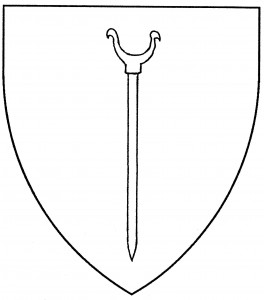A handgun rest is a long spiked pole with a forked top, designed to act as a brace and support for early firearms. Although a period artifact, dating from the late 16th Century [Stone 461], the handgun rest per se doesn’t appear to have been used in armory. The charge is acceptable for Society use, not only as a period artifact, but by its similarity to period charges: the artifacts in the arms of Waldstromer von Reichelsdorff, 1605 [Siebmacher 108], or the “oarlocks” (Italian scalmi) in the arms of de Galber, mid-15th C. [Triv 166]. By whatever name, the charge is palewise by default. See also fork.
Eadmond du Battlemont bears: Per pale embattled gules and Or, to dexter a handgonne rest Or and to sinister a slow match, ends in chief enflamed, proper.
Craig Joyful bears: Or, a handgun rest azure surmounted by a chevron inverted gules.
Edward the Tall bears: Argent, two oarlocks in saltire and on a chief azure three garbs Or.
